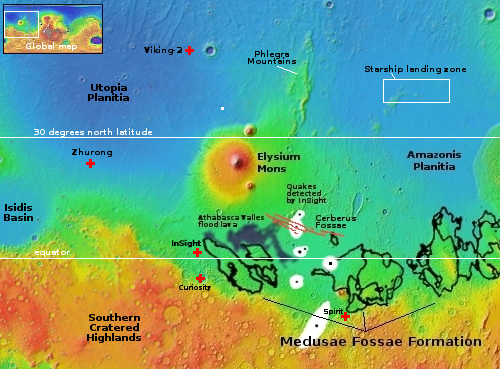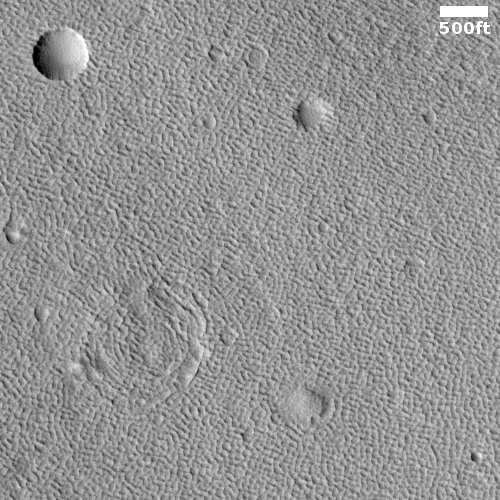A northern lowland ice sheet on Mars?
Cool image time. The picture to the right, cropped to post here, was taken on March 14, 2023 by the high resolution camera on Mars Reconnaissance Orbiter (MRO). Dubbed simply a “terrain sample,” this image was likely taken not as part of any specific research project, but to fill a gap in the camera’s schedule in order to maintain its temperature by taking regular images. When the camera team needs to do this, they try to find interesting locations not previously photographed. Sometimes the photos turn out somewhat boring. Most of the time however they capture something very intriguing.
In this case, the intriguing feature of this picture is its stippled surface that seems to overlay a relatively flat surface underneath, with some faint covered craters visible. On top are several more recent craters that suggest either the impact landed in very soft material, thus producing little ejecta and no crater rims or the craters are not craters but sinks, places where the ground is subsiding due to some underground process.

The white dot on the overview map to the right marks this location, about 500 miles north of the peak of the giant shield volcano Elysium Mons.
This is the northern lowland plains north of 30 degrees latitude, where data and images from many orbiters has found extensive evidence of near-surface ice. Thus, in the cool image above we are likely looking at an ice sheet that covers everything, itself covered with a thin layer of dust in order to prevent it from sublimating entirely away in the thin atmosphere. The stippled look likely comes from some sublimation regardless, either removing some material on top, or underground causing the surface to sag. In either case, this process makes the surface of this ice sheet uneven.
The overview map itself provides a lot of information of this part of Mars that I have accumulated with time. The latitude lines delineate the icy regions from the dry equatorial regions. The black outlines mark the regions covered by the Medusae Fossae Formation, the largest volcanic ash deposit on Mars and thought to be source of most of the planet’s dust. The white splotches indicate the largest quakes detected by the seismometer on InSight, with several centered on the long very distinct fissure cracks of Cerberus Fossae, marked by the red lines. The Athabasca flood lava is thought to be Mars’ most recent major volcanic event, less than ten million years old and covering an area about the size of Great Britain in only a few weeks at most.
This is also a region that has drawn a lot of landers/rovers from Earth. Five are shown on the map, with Perseverance just off the map’s left edge, on the western border of Isidis Basin. SpaceX has shown interesting in landing Starship in the region east of the Phelgra mountains, because it is relatively flat but also shows extensive evidence of the same kind of near-surface ice sheets.
On Christmas Eve 1968 three Americans became the first humans to visit another world. What they did to celebrate was unexpected and profound, and will be remembered throughout all human history. Genesis: the Story of Apollo 8, Robert Zimmerman's classic history of humanity's first journey to another world, tells that story, and it is now available as both an ebook and an audiobook, both with a foreword by Valerie Anders and a new introduction by Robert Zimmerman.
The print edition can be purchased at Amazon or from any other book seller. If you want an autographed copy the price is $60 for the hardback and $45 for the paperback, plus $8 shipping for each. Go here for purchasing details. The ebook is available everywhere for $5.99 (before discount) at amazon, or direct from my ebook publisher, ebookit. If you buy it from ebookit you don't support the big tech companies and the author gets a bigger cut much sooner.
The audiobook is also available at all these vendors, and is also free with a 30-day trial membership to Audible.
"Not simply about one mission, [Genesis] is also the history of America's quest for the moon... Zimmerman has done a masterful job of tying disparate events together into a solid account of one of America's greatest human triumphs."--San Antonio Express-News
Cool image time. The picture to the right, cropped to post here, was taken on March 14, 2023 by the high resolution camera on Mars Reconnaissance Orbiter (MRO). Dubbed simply a “terrain sample,” this image was likely taken not as part of any specific research project, but to fill a gap in the camera’s schedule in order to maintain its temperature by taking regular images. When the camera team needs to do this, they try to find interesting locations not previously photographed. Sometimes the photos turn out somewhat boring. Most of the time however they capture something very intriguing.
In this case, the intriguing feature of this picture is its stippled surface that seems to overlay a relatively flat surface underneath, with some faint covered craters visible. On top are several more recent craters that suggest either the impact landed in very soft material, thus producing little ejecta and no crater rims or the craters are not craters but sinks, places where the ground is subsiding due to some underground process.

The white dot on the overview map to the right marks this location, about 500 miles north of the peak of the giant shield volcano Elysium Mons.
This is the northern lowland plains north of 30 degrees latitude, where data and images from many orbiters has found extensive evidence of near-surface ice. Thus, in the cool image above we are likely looking at an ice sheet that covers everything, itself covered with a thin layer of dust in order to prevent it from sublimating entirely away in the thin atmosphere. The stippled look likely comes from some sublimation regardless, either removing some material on top, or underground causing the surface to sag. In either case, this process makes the surface of this ice sheet uneven.
The overview map itself provides a lot of information of this part of Mars that I have accumulated with time. The latitude lines delineate the icy regions from the dry equatorial regions. The black outlines mark the regions covered by the Medusae Fossae Formation, the largest volcanic ash deposit on Mars and thought to be source of most of the planet’s dust. The white splotches indicate the largest quakes detected by the seismometer on InSight, with several centered on the long very distinct fissure cracks of Cerberus Fossae, marked by the red lines. The Athabasca flood lava is thought to be Mars’ most recent major volcanic event, less than ten million years old and covering an area about the size of Great Britain in only a few weeks at most.
This is also a region that has drawn a lot of landers/rovers from Earth. Five are shown on the map, with Perseverance just off the map’s left edge, on the western border of Isidis Basin. SpaceX has shown interesting in landing Starship in the region east of the Phelgra mountains, because it is relatively flat but also shows extensive evidence of the same kind of near-surface ice sheets.
On Christmas Eve 1968 three Americans became the first humans to visit another world. What they did to celebrate was unexpected and profound, and will be remembered throughout all human history. Genesis: the Story of Apollo 8, Robert Zimmerman's classic history of humanity's first journey to another world, tells that story, and it is now available as both an ebook and an audiobook, both with a foreword by Valerie Anders and a new introduction by Robert Zimmerman.
The print edition can be purchased at Amazon or from any other book seller. If you want an autographed copy the price is $60 for the hardback and $45 for the paperback, plus $8 shipping for each. Go here for purchasing details. The ebook is available everywhere for $5.99 (before discount) at amazon, or direct from my ebook publisher, ebookit. If you buy it from ebookit you don't support the big tech companies and the author gets a bigger cut much sooner.
The audiobook is also available at all these vendors, and is also free with a 30-day trial membership to Audible.
"Not simply about one mission, [Genesis] is also the history of America's quest for the moon... Zimmerman has done a masterful job of tying disparate events together into a solid account of one of America's greatest human triumphs."--San Antonio Express-News


